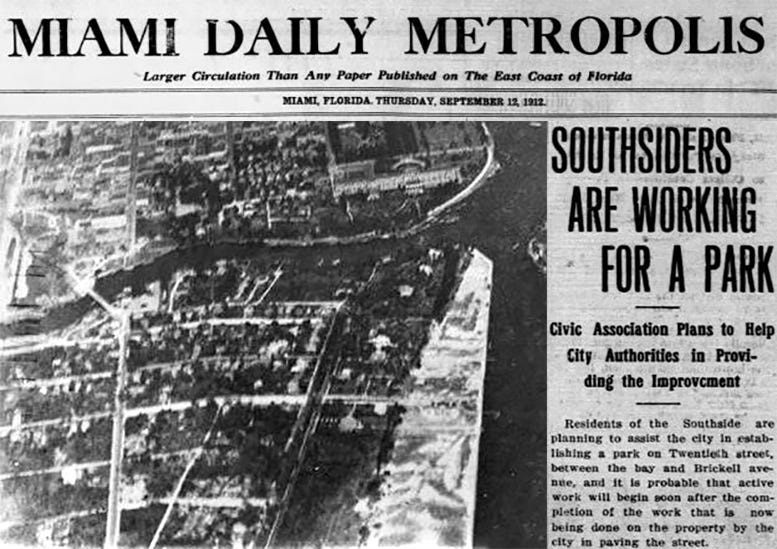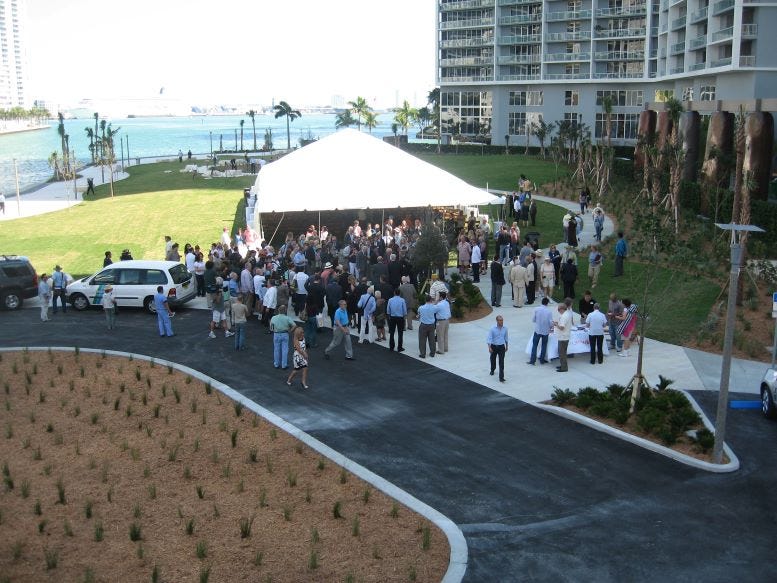Brickell Green Space Established in 1912
The story of the Brickell neighborhood's parks and green space through the years.

The Southside Civic Association, composed of residents from the neighborhood then known as Southside—later Brickell—had long championed the creation of a local park to benefit the community and enhance the area's appearance. When they approached the city council’s parks committee, they were told that no budget existed for new parks, but the committee did offer an alternative idea for creating green space in the neighborhood.
According to an article published in the Miami Metropolis September 12, 1912, the partnership between civic organization and city occurred during a city council meeting when “Mr. Casper Hefty, a park committee member of the city council, stated this morning that while the city did not have the funds for extensive improvements of the parks, that a great deal could be accomplished if the people of the Southside would co-operate with him in the work.”
In the fall of 1912, the city began paving SE Eighth Street from Brickell Avenue to the bay in a parkway style, leaving a landscaped median intended for trees, shrubs, and a children's play area. While the city supplied the materials, members of the Southside Civic Association volunteered their labor, helping to create one of the neighborhood’s earliest parks.
Alongside plans for a makeshift park, the Southside Civic Association also aimed to build a recreation pier at the end of SE Eighth Street. In September 1912, they were in negotiations with Mary Brickell to purchase the riparian rights needed for the project, but the plan ultimately never came to fruition.
Although the median along SE Eighth Street offered Southside residents a modest green space, the neighborhood gained its first permanent park in 1913 with the creation of Jungle Park—later renamed Simpson Park in 1931 in honor of botanist and conservationist Charles Torrey Simpson. A second park followed in 1924, when the Brickell family donated part of their estate to establish Mary Brickell Park, named after the family's matriarch.
A third park was added in the late 1930s with the creation of South Side Park, located near the Brickell Metrorail station, followed by a fourth in 1972 with the opening of Alice Wainwright Park, named in honor of Miami’s first female city commissioner. Over the years, several smaller pocket parks have also been established through land donations, including Triangle Park along SW Fifteenth Road and Allen Morris Brickell Park at 25 SE 10th Street. In 2012, 1814 Brickell Park was dedicated just south of Immanuel Lutheran Church on Brickell Avenue, featuring a 9/11 Memorial that includes a steel beam from the World Trade Center. It was later renamed to Tibor Hollo Park in May of 2023.
In 1998, a 2,000-year-old archaeological site was uncovered near the mouth of the Miami River, offering significant insight into the region’s earliest inhabitants. Originally slated for a waterfront condominium development, the project was halted following the discovery. In 2002, the State of Florida purchased the 2.5-acre property from developer Michael Baumann for $26.7 million, after it was listed on the National Register of Historic Places. The site was later designated a National Historic Landmark on January 16, 2009, and officially opened as a park on February 23, 2011.
Maintaining and expanding park space in Miami’s Brickell neighborhood has long been a challenge, as ongoing development continues to draw more residents and increase pressure to turn open land into high-rise condominiums. Now more than ever, it is essential for the city and its residents to advocate not only for the preservation of existing parks, but also for the creation of new green spaces to serve future generations.
Resources:
Miami Metropolis: “Southsiders are Working for a Park”, September 12, 1912.





When population density was low and most people lived in single-family structures with land, a lack of public green space would be less an issue. The high-density Brickell of today, however, is in real need of additional green spaces. Alice Wainwright Park is a great spot, but it's on the other side of the Rickenbacker.
I think we have reached the point where both the public and the municipalities have reached a consensus on how much benefit green spaces confer on an area. Kennedy Park in Coconut Grove has been a resounding success. Parking is limited. In the Gables, the city has a policy of buying properties to make micro parks that are the size of one or two lots and serve the nearby residents. Paris, Madrid, and London have their many attractions, but can one really do better than the Luxembourg Gardens, Parque del Buen Retiro or Regeant's Park?